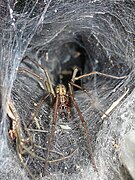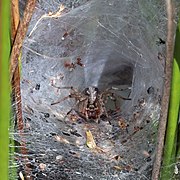Agelenidae
| Funnel weavers Temporal range:
| |
|---|---|

| |
| Grass spider (Agelenopsissp.), female | |

| |
| Hobo spider (E. agrestis) | |
| Scientific classification | |
| Domain: | Eukaryota |
| Kingdom: | Animalia |
| Phylum: | Arthropoda |
| Subphylum: | Chelicerata |
| Class: | Arachnida |
| Order: | Araneae |
| Infraorder: | Araneomorphae |
| Family: | Agelenidae C. L. Koch,1837 |
| Diversity | |
| 92 genera,1374 species | |

| |
TheAgelenidaeare a large family of spiders in the suborderAraneomorphae.Well-known examples include the common "grass spiders" of the genusAgelenopsis.Nearly all Agelenidae are harmless to humans, but the bite of thehobo spider(Eratigena agrestis) may be medically significant, and some evidence suggests it might cause necrotic lesions,[1]but the matter remains subject to debate.[2]The most widely accepted common name for members of the family isfunnel weaver.[3]
Description
[edit]The body length of the smallest Agelenidae spiders are about 4 mm (0.16 in), excluding the legs, while the larger species grow to 20 mm (0.79 in) long. Some exceptionally large species, such asEratigena atrica,may reach 5 to 10 cm (2.0 to 3.9 in) in total leg span.
Agelenids have eight eyes in two horizontal rows of four. Theircephalothoracesnarrow somewhat towards the front where the eyes are. Their abdomens are more or less oval, usually patterned with two rows of lines and spots. Some species have longitudinal lines on the dorsal surface of the cephalothorax, whereas other species do not; for example, the hobo spider does not, which assists in informally distinguishing it from similar-looking species.[4]
Biology
[edit]
Most of the Agelenidae are very fast runners, especially on their webs. With speeds clocked at 1.73 ft/s (0.53 m/s), thegiant house spiderheld theGuinness Book of World Recordstitle for top spider speed until 1987. A recent literature review found peer-reviewed accounts of several agelenid species achieving speeds in this range, though some other taxa have achieved higher speeds.[5][6]
Agelenids build a flat sheet of nonsticky web with a funnel-shaped retreat to one side or occasionally in the middle, depending on the situation and species. Accordingly, "funnel weaver" is the most widely accepted common name for members of the family, but they should not be confused with the so-called "funnel-web tarantulas" or "funnel-web spiders" ofmygalomorphfamilies.[3]
The typical hunting mode for most sheet-building Agelenidae is similar to that of most other families of spiders that build sheet webs in the open, typically on grass or inscrublandas opposed to under bark, rocks, and the like. They await the arrival of prey such as grasshoppers that fall onto the horizontal web. Although the web is not sticky, it is full of entangling filaments that the spider continually lays down when passing over. The filaments catch in the least projections on a prey insect's body or limbs. The web also is springy, and whether perching on the sheet or awaiting prey in its retreat, the spider reacts immediately to vibrations, whether from a courting male, the threatening struggles of dangerous invaders, or the weaker struggles of potential meals. They attack promising prey by rushing out at high speed and dealing a paralysing venomous bite. The agatoxin in their venom has been studied extensively inAgelenopsis aperta.[7]Once the prey has been disabled, the spider generally drags it back into the retreat and begins to feed. This method of attack is consistent with the high speeds at which the Agelenidae run. Other sheet-web hunters such as somePisauridaealso are very fast runners.
Like any fast-running spider, the Agelenidae possess good vision, and are generally photosensitive (i.e. react to changes in the light), so they can successfully retreat upon perceiving a larger threat's shadow approaching. Some are also sensitive to wind blows, and can retreat before the prey even spots them. Males are less successful ambushers than females, so prefer to roam around and wander to new areas, rather than stay in one single web. In September, males of outdoors species (such asAgelenopsisandAgelena) can seek refuge within houses, usually nesting on or underneath outer windowsills, or also around the porch door. These spiders often are neither pest controllers nor pests themselves; they are very selective in their prey, and do not consume large quantities; also, they are immune to intimidation and come back to their webs even after being disturbed, unless they are completely destroyed.
Parasocial species
[edit]The type genus,Agelena,includes someparasocialspiders that live in complex communal webs in Africa. The best known of these is probablyA. consociata.Social behaviourin these spiders comprises communal web-building, cooperative prey capture, and communal rearing of young. Notrophallaxisoccurs, though, nor does any trueeusocialitysuch as occurs in the socialHymenoptera(ants, bees, and wasps); for example, the spiders have no castes such as sterile workers or soldiers, and all females are reproductive.[8]
Medical significance
[edit]Only one species of agelenid has become prominent as a putative cause of a significant frequency ofnecrotic arachnidism;this is thehobo spider,Eratigena agrestis.[4]This perception arose when the species was accidentally introduced to the United States in the mid-20th century and propagated rapidly in several regions. It is a fairly large, rapidly moving spider, so accordingly alarms many people.[9]A few cases of bites have been reported in Southern California by the desert grass spider,Agelenopsis aperta,that resulted in symptoms, but determining whether these cases were confused with similar-looking spiders is difficult.[10]
Genera
[edit]As of January 2023[update],theWorld Spider Catalogaccepts these genera:[11]
- AcutipetalaDankittipakul & Zhang, 2008— Thailand
- AeolocoelotesOkumura, 2020— Japan
- AgelenaWalckenaer, 1805— Africa, Asia, Italy
- AgelenellaLehtinen, 1967— Yemen
- AgelenopsisGiebel, 1869— North America, Ukraine, Asia
- AgeleradixXu & Li, 2007— China
- AgelescapeLevy, 1996— Asia
- AhuaForster & Wilton, 1973— New Zealand
- AllagelenaZhang, Zhu & Song, 2006— Asia
- AlloclubionoidesPaik, 1992— Asia
- AsiascapeZamani&Marusik,2020— Iran
- AterigenaBolzern, Hänggi & Burckhardt, 2010— China, Italy, France
- AzerithonicaGuseinov, Marusik & Koponen, 2005
- BajacalilenaMaya-Morales & Jiménez, 2017— Mexico
- BarronopsisChamberlin & Ivie, 1941— Cuba, United States
- BenoitiaLehtinen, 1967— Asia, Africa, Spain
- BifidocoelotesWang, 2002— China
- CabolenaMaya-Morales & Jiménez, 2017— Mexico
- CalilenaChamberlin & Ivie, 1941— United States, Mexico
- CallidalenaMaya-Morales & Jiménez, 2017— Mexico, United States
- CoelotesBlackwall, 1841— Asia, Europe, Mexico
- CorasSimon, 1898— United States, Canada, Korea
- CurticoelotesOkumura, 2020— Japan
- DichodactylusOkumura, 2017— Japan
- DraconariusOvtchinnikov, 1999— Asia
- EratigenaBolzern, Burckhardt & Hänggi, 2013— North America, Europe, Algeria, Asia
- FemoracoelotesWang, 2002— Taiwan
- FlexicoelotesChen, Li & Zhao, 2015— China
- GorbiscapeZamani & Marusik, 2020— Western Mediterranean, Tajikistan
- GriseidraconariusOkumura, 2020— Japan
- GuilotesZhao & S. Q. Li, 2018— China
- HaditesKeyserling, 1862— Croatia
- HengconariusZhao & S. Q. Li, 2018— China
- HimalcoelotesWang, 2002— Nepal, Bhutan, China
- HistoponaThorell, 1869— Europe
- HoffmannilenaMaya-Morales & Jiménez, 2016— Mexico, Guatemala
- HololenaChamberlin & Gertsch, 1929— United States, Canada, Mexico
- HuangyuaniaSong & Li, 1990— China
- HukaForster & Wilton, 1973— New Zealand
- HypocoelotesNishikawa, 2009— Japan
- InermocoelotesOvtchinnikov, 1999— Europe
- IwogumoaKishida, 1955— Asia
- JishiyuLin & Li, 2023— China
- KiduguaLehtinen, 1967— Congo
- LagunellaMaya-Morales & Jiménez, 2017
- LeptocoelotesWang, 2002— Taiwan
- LineacoelotesXu, Li & Wang, 2008— China
- LongicoelotesWang, 2002— China, Japan
- LycosoidesLucas, 1846— Africa, Azerbaijan, Spain
- MahuraForster & Wilton, 1973— New Zealand
- MaimunaLehtinen, 1967— Asia, Greece
- MalthonicaSimon, 1898— Greece, Portugal, France
- MelpomeneO. Pickard-Cambridge, 1898— North America, Central America
- MistariaLehtinen, 1967— Kenya, Yemen
- NeorepukiaForster & Wilton, 1973— New Zealand
- NeotegenariaRoth, 1967— Guyana
- NeowadotesAlayón, 1995— Hispaniola
- NesiocoelotesOkumura & Zhao, 2022— Japan
- NotiocoelotesWang, Xu & Li, 2008— China
- NovalenaChamberlin & Ivie, 1942— North America, Central America, Trinidad
- NuconariusZhao & S. Q. Li, 2018— China
- OloruniaLehtinen, 1967— Congo
- OramiaForster, 1964— New Zealand, Australia
- OramiellaForster & Wilton, 1973— New Zealand
- OrumcekiaKoçak & Kemal, 2008— China, Vietnam
- PapiliocoelotesZhao & Li, 2016— China
- ParamyroForster & Wilton, 1973— New Zealand
- PersilenaZamani & Marusik, 2020— Iran
- PersiscapeZamani & Marusik, 2020— Western Asia, Greece
- PireneitegaKishida, 1955— Asia, Europe
- PlatocoelotesWang, 2002— China, Japan
- PorotakaForster & Wilton, 1973— New Zealand
- PseudotegenariaCaporiacco, 1934— Libya
- RobusticoelotesWang, 2002— China
- RothilenaMaya-Morales & Jiménez, 2013— Mexico
- RualenaChamberlin & Ivie, 1942— United States, Mexico
- SinocoelotesZhao & Li, 2016— China, Thailand
- SinodraconariusZhao & S. Q. Li, 2018— China
- SpiricoelotesWang, 2002— China, Japan
- TamgriniaLehtinen, 1967— India, China
- TararuaForster & Wilton, 1973— New Zealand
- TegecoelotesOvtchinnikov, 1999— Asia
- TegenariaLatreille, 1804— Europe, Asia, Africa, North America, Oceania, South America, Jamaica
- TextrixSundevall, 1833— Asia, Europe, Ethiopia
- TikaderiaLehtinen, 1967— Himalayas
- TonsillaWang & Yin, 1992— China
- TortolenaChamberlin & Ivie, 1941— United States, Mexico, Costa Rica
- TroglocoelotesZhao & S. Q. Li, 2019— China
- TuapokaForster & Wilton, 1973— New Zealand
- UrocorasOvtchinnikov, 1999— Europe, Turkey
- VappolotesZhao & S. Q. Li, 2019— China
- WadotesChamberlin, 1925— United States, Canada
A number of fossil species are known fromEoceneagedBaltic amber,but their exact relationship with extant members of the clade is unclear.[12]
-
femaleE. atricaat the mouth of her retreat
-
Funnel web of an agelenid from Spain
-
Agelena labyrinthicafemale in web
-
A. labyrinthica,male (immature)
See also
[edit]References
[edit]- ^Goddard, Jerome (3 December 2012).Physician's Guide to Arthropods of Medical Importance(6th ed.). CRC Press. p. 380.ISBN978-1-4398-5085-5– via Google Books.
- ^Gaver-Wainwright, Melissa M.; Zack, Richard S.; Foradori, Matthew J.; Lavine, Laura Corley (2011)."Misdiagnosis of Spider Bites: Bacterial Associates, Mechanical Pathogen Transfer, and Hemolytic Potential of Venom from the Hobo Spider, Eratigena agrestis (Araneae: Agelenidae)".Journal of Medical Entomology.48(2): 382–388.doi:10.1603/ME09224.PMID21485377.
- ^abBreene; et al. (2003).Common Names of Arachnids(PDF)(5th ed.). Archived fromthe original(PDF)on 2006-09-27.Retrieved2006-09-27.
- ^abVetter, R. S., and A. L. Antonelli. 2002. How to identify (or misidentify) the hobo spider. Wash. St. Coop. Ext. Pest Leafl. Series No. 116
- ^Spagna, J. C.; Peattie, A. M. (2012). "Terrestrial locomotion in arachnids".Journal of Insect Physiology.58(5): 599–606.doi:10.1016/j.jinsphys.2012.01.019.PMID22326455.
- ^Gorb, S.N.; Barth, F.G. (1994). "Locomotor behavior during prey-capture of a fishing spider, Dolomedes plantarius (Araneae: Araneidae): galloping and stopping".The Journal of Arachnology.22:89–93.
- ^Adams, Michael E. (April 2004)."Agatoxins: ion channel specific toxins from the american funnel web spider, Agelenopsis aperta".Toxicon.43(5): 509–525.doi:10.1016/j.toxicon.2004.02.004.ISSN0041-0101.PMID15066410.
- ^Rainer Foelix (3 December 2010).Biology of Spiders.Oxford University Press, USA. pp. 320–.ISBN978-0-19-981324-7.
- ^Vetter, Richard S.; Isbister, Geoffrey K. (December 2004). "Do Hobo Spider Bites Cause Dermonecrotic Injuries?".Annals of Emergency Medicine.44(6): 605–7.doi:10.1016/j.annemergmed.2004.03.016.PMID15573036.
- ^Vetter, Richard S (December 1998)."Envenomation by a spider, Agelenopsis aperta (Family: Agelenidae) Previously Considered Harmless".Annals of Emergency Medicine.32(6): 739–741.doi:10.1016/s0196-0644(98)70076-9.ISSN0196-0644.PMID9832673.
- ^"Family: Agelenidae C. L. Koch, 1837".World Spider Catalog.Natural History Museum Bern.Archivedfrom the original on 2023-01-19.Retrieved2023-01-19.
- ^Magalhaes, Ivan L. F.; Azevedo, Guilherme H. F.; Michalik, Peter; Ramírez, Martín J. (February 2020)."The fossil record of spiders revisited: implications for calibrating trees and evidence for a major faunal turnover since the Mesozoic".Biological Reviews.95(1): 184–217.doi:10.1111/brv.12559.ISSN1464-7931.PMID31713947.S2CID207937170.
Further reading
[edit]- Kaston, Benjamin Julian(1953).How to Know the Spiders.Pictured key nature series (1st ed.). Dubuque, IA: W.C. Brown Co.ISBN0-697-04898-5.OCLC681432632.
- Foelix, Rainer F.(2011).Biology of Spiders(3rd ed.). Oxford: Oxford University Press.ISBN978-0-19-973482-5.OCLC963876029.




